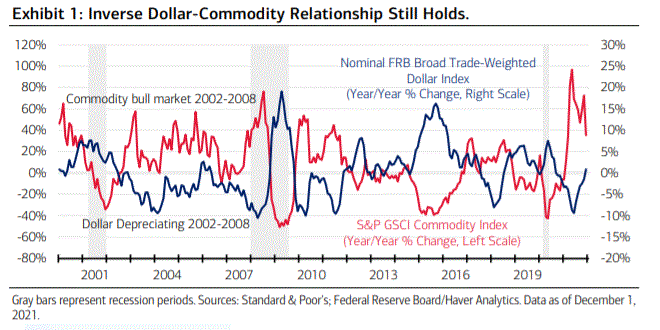Merrill ser tegn på stigende råvarepriser på nogle områder, især i relation til digitaliseringen og den grønne økonomi, der fører til en stigende efterspørgsel efter nye råvarer. Der kan ventes en større prisstigning i råvarer end i aktier i det nye år. Det hænger også sammen med, at økonomien normaliseres, og det styrker råvarerne, også på grund af den høje inflation. Grundlæggende styrkes råvarepriserne af den pæne globale vækst samt den svage dollar.
Macro Backdrop Supportive Of Commodities in 2022
For investors, there is a growing list of reasons to shore up strategic exposure to
commodity prices heading into 2022. Supply-side shortcomings related to the coronavirus,
bad weather and crop failures are short-term factors that may fade as tailwinds, but rising
maritime-based geopolitical risk and positive commodity supply/demand dynamics related
to decarbonization efforts appear to have staying power.
A weaker dollar, potentially driven
by valuations, could eventually emerge as an additional catalyst. At the same time, investor
flows are revisiting the diversification benefits of Commodities.
From a business cycletiming perspective, Commodity allocations often exhibit relative
outperformance versus
stocks and bonds when the labor market is tight and inflation is bubbling over. Ultimately,
we believe global growth anchors demand and is the most important factor to consider
when allocating to Commodities, and that outlook is positive for 2022, in our view.

Below we summarize these tailwinds, recently highlighted by BofA Global Research, and
also note risks related to the positive outlook.
Business Cycle Positioning Supportive of Relative Performance
Historical analysis of business cycles suggests that Commodities could be entering a
sweet spot of relative performance versus Equities and Fixed Income. Commodities tend
to benefit on a relative basis from a more mature expansionary phase of the business
cycle when the labor market is tight and capacity utilization and inflationary pressures are
high.
Central banks are often raising interest rates to ward off inflation when growth is
peaking, favoring commodities over Fixed Income, which tends to struggle when interest
rates are moving higher. And Equities tend to perform well early in a business-cycle
expansion because they are discounting faster future growth. Indeed, Equities have been
on a tear the last year and a half.
Most importantly, Commodities as an asset class have
tended to offer important diversification benefits at this stage of the cycle because
various commodity investment strategies can benefit from the inflation that hurts other
asset classes.
Global Growth Underpins Demand for Commodities
Fundamentally, two key drivers of Commodities are global growth, which underpins
demand, and the dollar. On the growth side, according to BofA Global Research, November
29 Purchasing Managers’ Indexes (PMI) in 39 out of 41 countries they track are in
expansionary territory, and the Global Manufacturing PMI, a proxy for global cyclical
momentum, is at a strong 54.3 (with an index level above 50 signaling expansion). For the
year ahead, they expect solid real global growth of 4.2% even as the growth recovery in
Emerging Markets (EM) lags.
Across the globe, monetary policy is likely to remain accommodative even as the global
monetary tightening cycle expands and accelerates. In aggregate, central bank balance
sheets will likely still expand for the calendar year 2022, and fiscal stimulus is supportive
of growth and demand for commodities.
A more targeted source of demand comes from the energy restructuring taking place that
is supportive of Commodities related to decarbonization. Here the supply chain will take
time to develop and mature, creating opportunities for Commodity investors to benefit
from demand and supply imbalances.

